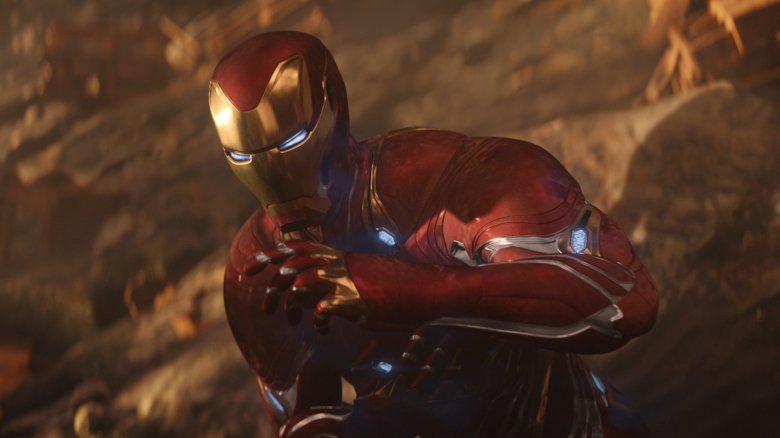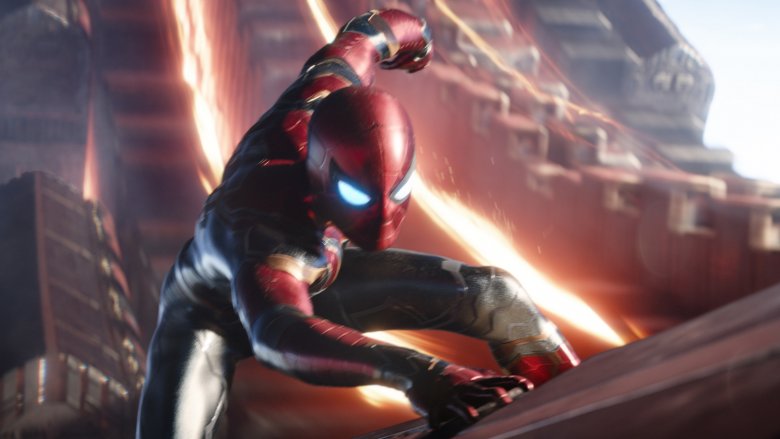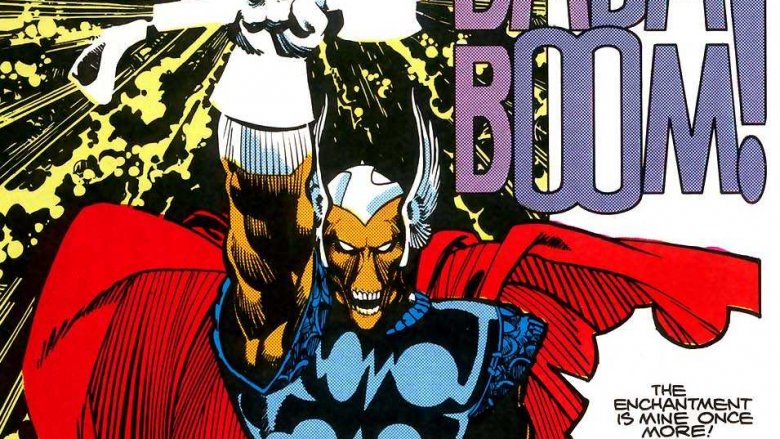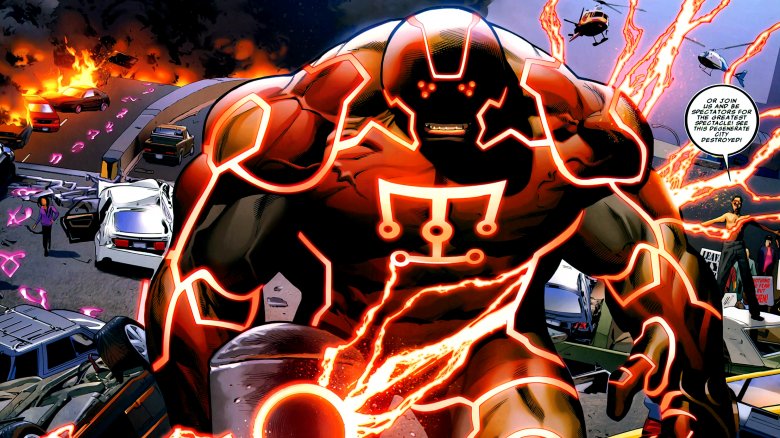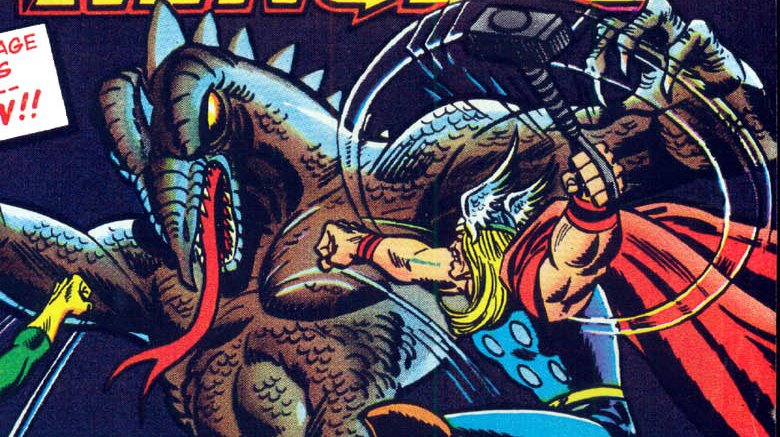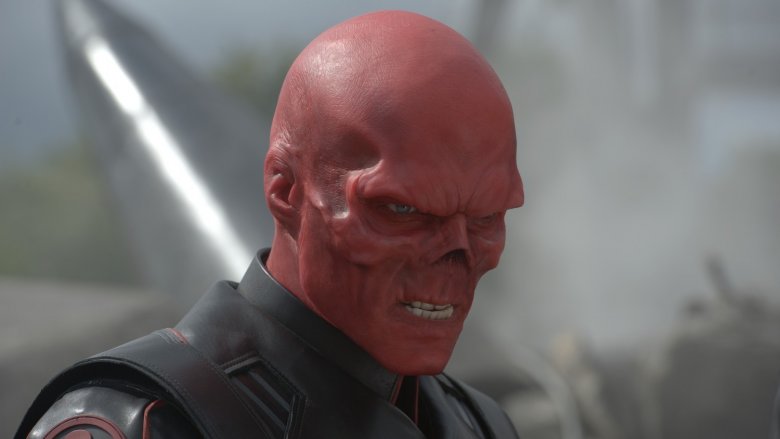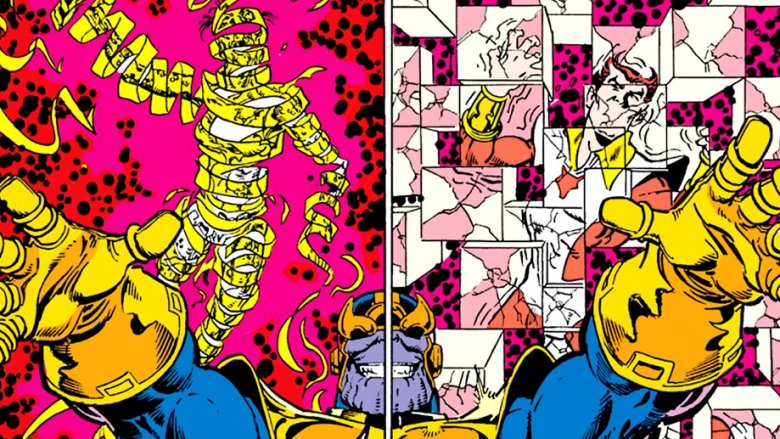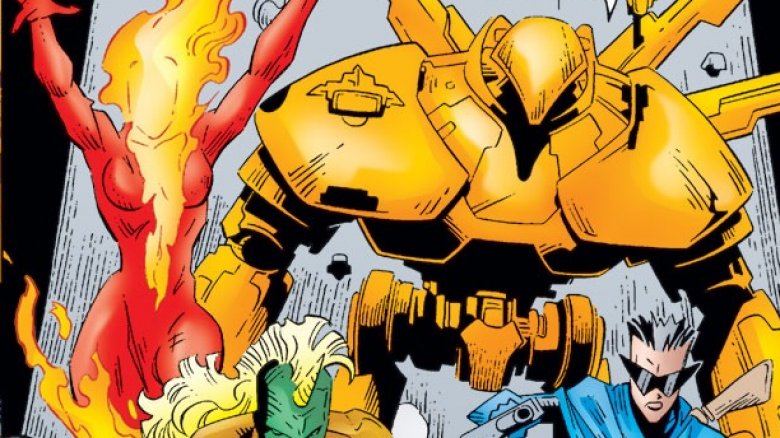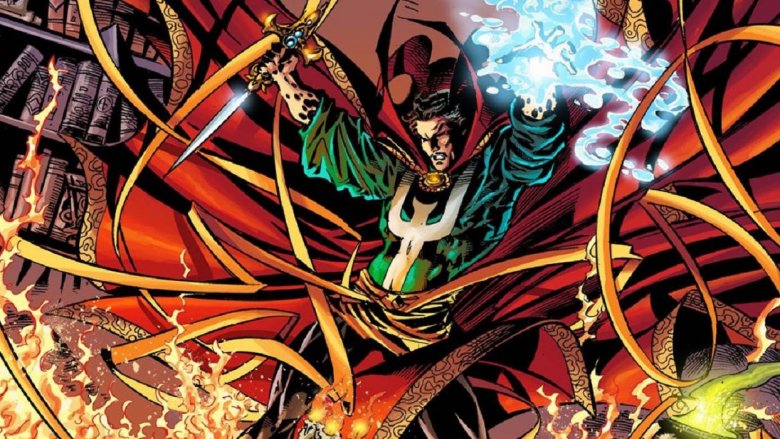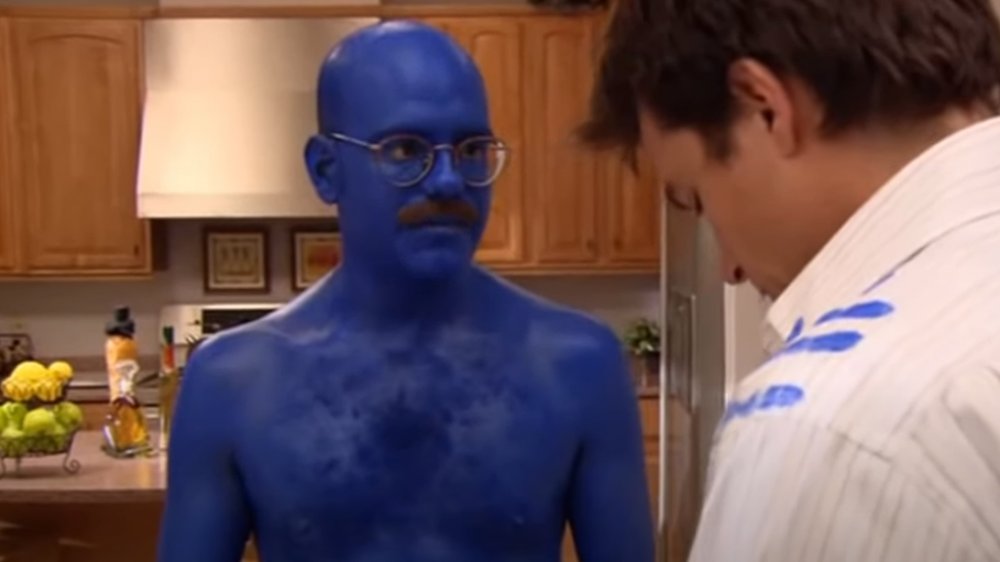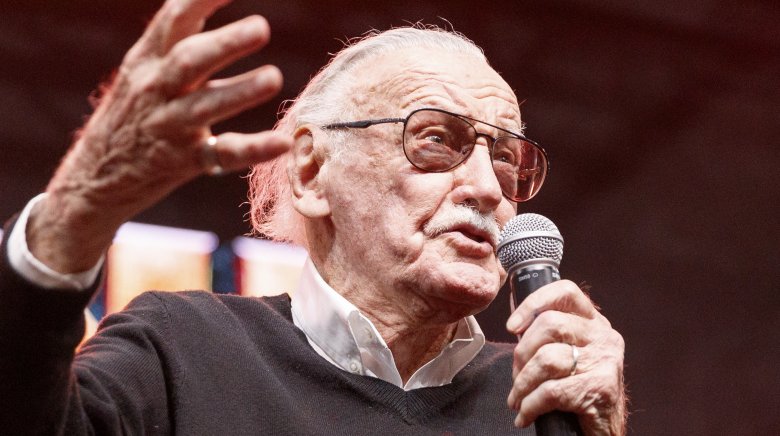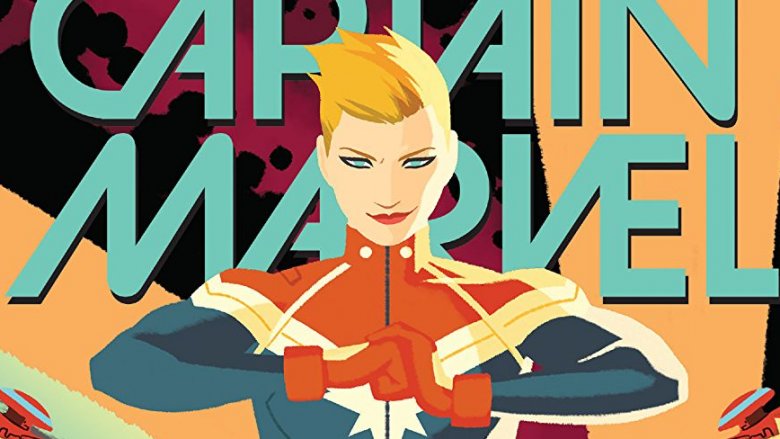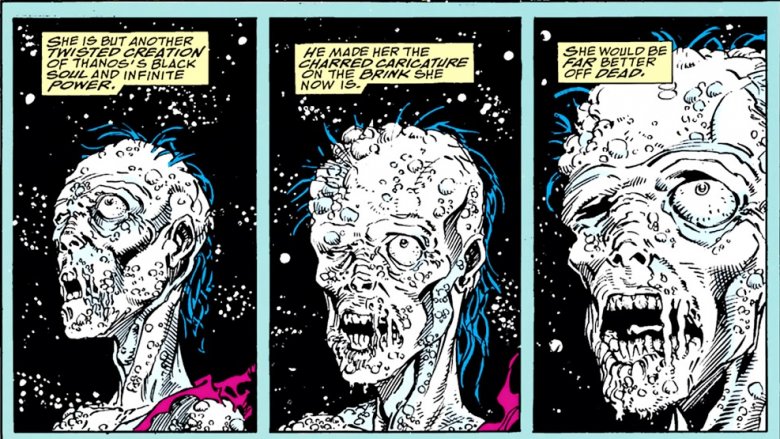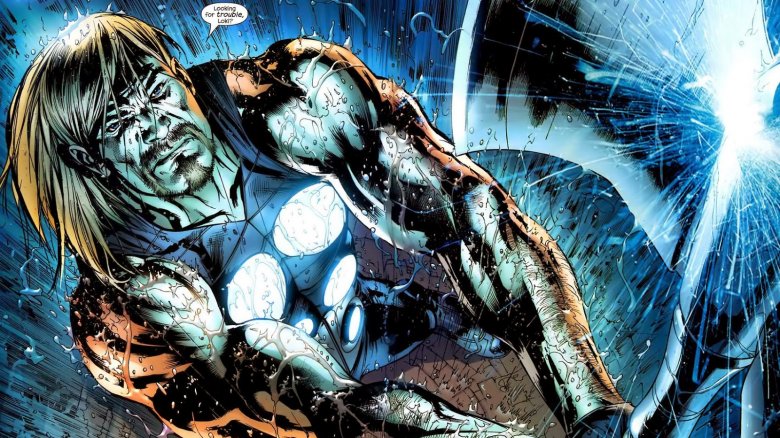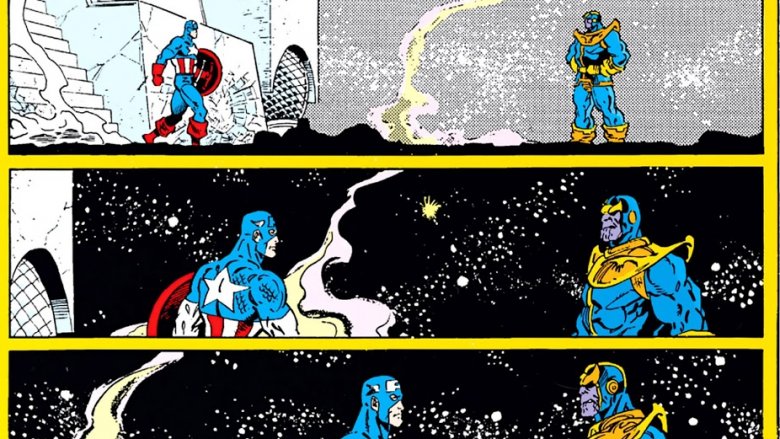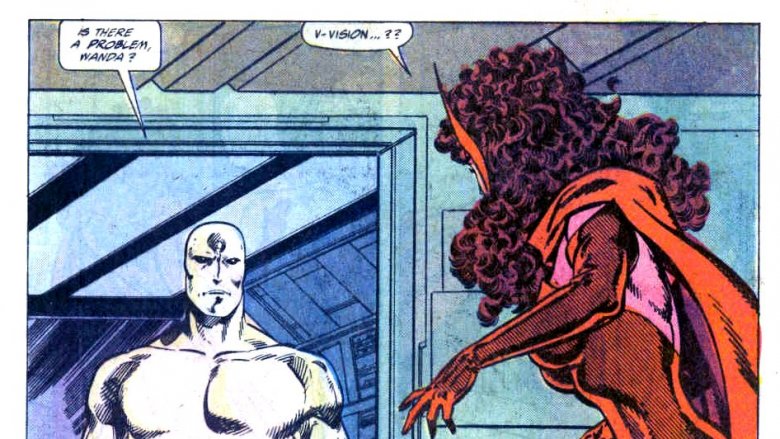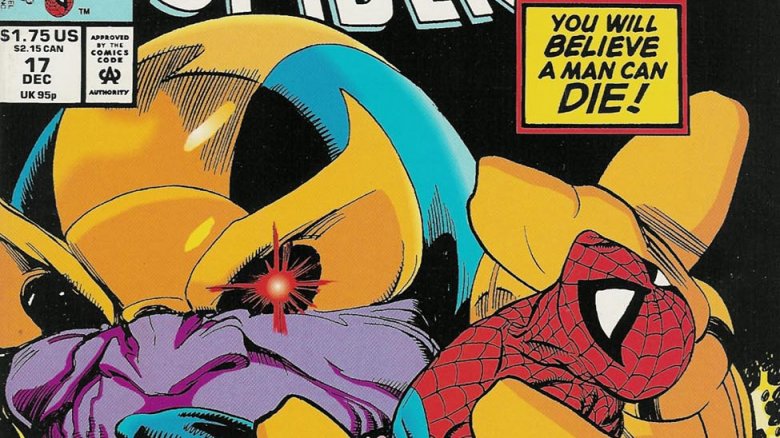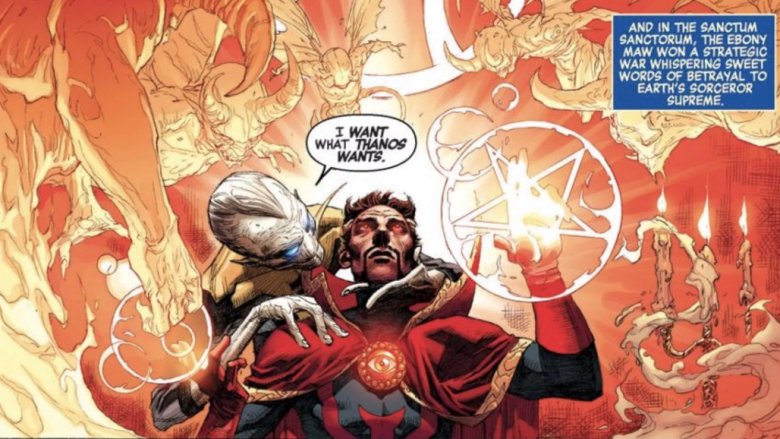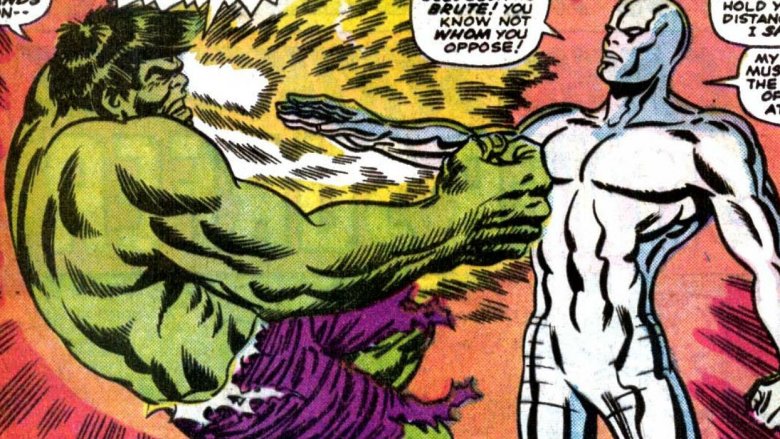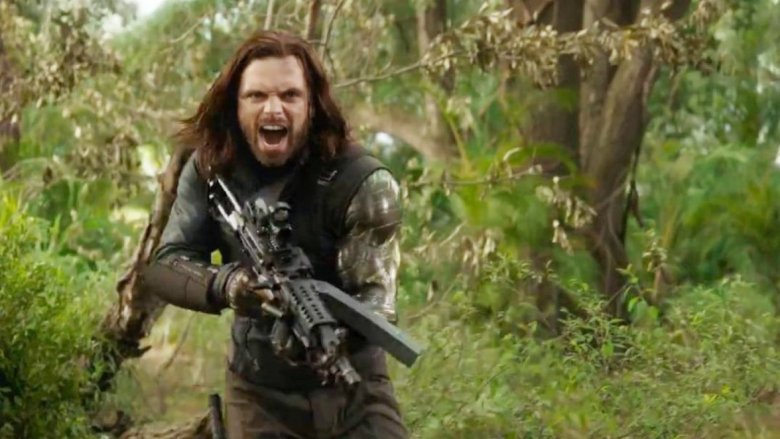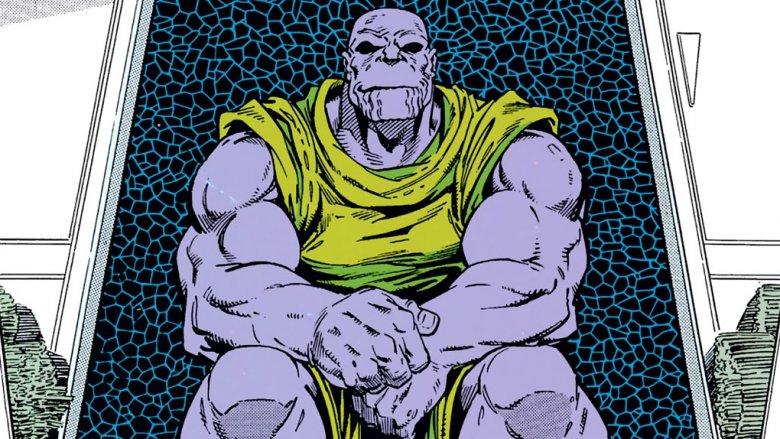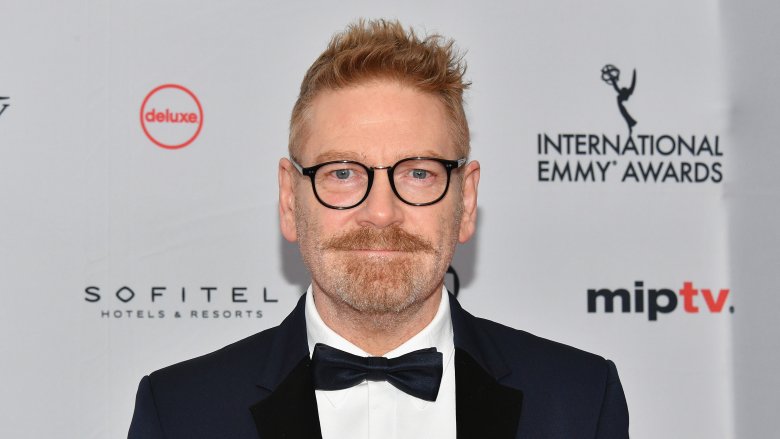Avengers: Infinity War Easter Eggs You Missed
Ten years in the making, Avengers: Infinity War is the culmination of all of Marvel's awesome efforts on the big screen, marking the end of many things... and very likely the beginning of even more things. Not a single film in the studio's blockbuster repertoire has passed without dropping a good handful of Easter eggs, and even though Infinity War is pretty focused on the here and now rather than the deeper secrets hidden within the pages of Marvel Comics, this movie didn't disappoint True Believers — in fact, its many true-to-comics scenes and unexpected callbacks darn near stole the show, which is pretty impressive given that "the show" was basically most of the MCU fighting Thanos for the fate of the entire universe. The battles have raged and the end credits have rolled, so here's a spoiler-filled look at a few of the Easter eggs you may have missed in Avengers: Infinity War.
The Mark L
Tony Stark is probably a few hundred armors deep when it comes to his comics counterpart, but in the MCU, he's just reached armor number 50: the Mark L. This time around, he's dropped the complicated suit-up gantry, the fancy suitcase, and even the legion of armors that can just fly around and protect him from his enemies.
Tony's newest armor, which he wears in a small box on his chest, is all about portability and convenience, and it's pulled directly from a couple of comics sources. Iron Man's S.K.I.N. armor debuted in 2001, and was mostly housed in a small, self-contained unit which could release a simple, liquefied form of armor around his whole body instantly. Later, Iron Man's Bleeding Edge armor would do something similar, except it formed a complete suit of armor... and it was housed in the hollows of Tony's bones, rather than in an oversized locket. Kind of gross, but anything to not have to wear gaudy, glowing jewelry, right?
A few extra legs
We've been seeing previews of Spider-Man in his fancy new "Iron Spider" armor for months now, after he'd first rejected it at the end of Homecoming. It's not far into the movie before he gets his first feel for the slick new suit — and immediately stows away on the trip to Titan, much to Tony's chagrin. But in spite of the many sneak peeks, and unless you caught one very specific statue design leaked way too early, nobody really expected the suit to sprout a bunch of extra legs and save the day. That is, unless you're familiar with the Stark-designed armor in the comics, which has exactly that feature. While it initially seemed too outlandish for the big screen, those extra appendages definitely came in handy. And when Iron Man can combine his feet to make one giant rocket-foot, a couple of extra spider-legs isn't really that weird anymore.
Stormbreaker
Rest in pieces, Mjolnir. Marvel's God of Thunder was left without his magic hammer for most of Thor: Ragnarok, but it was pretty much inevitable that the guy known for swinging a mystical weapon would end up getting his hands on another one pretty quickly. In this case, Thor's new accessory goes by the name of Stormbreaker. Loyal comics readers, of course, know that name's already long since been taken — in fact, it's the name of Beta Ray Bill's hammer, marking the second time that the powerful, Thor-like space-deer has been referenced in the MCU (the first coming when he spotted an enormous bust honoring the character on the Grandmaster's arena on Sakaar). Bill is definitely out there in the galaxy somewhere — assuming he wasn't reduced to dust in Thanos' great culling of the universe, anyway — and Stormbreaker is ready for his arrival. Can his first full Marvel Cinematic Universe appearance be far behind?
Fear Itself
Speaking of Asgardian allies, Thor seems to have pals spread across both the known and unknown parts of the galaxy. Comics fans might notice that Marvel is once again borrowing parts of their own previously published arcs for their blockbuster movies. They've made significant tweaks to Civil War and Planet Hulk to get them to the big screen, and this time, Fear Itself plays a minor role, albeit in a very patchwork manner. All of the essentials are there: one of Earth's mightiest heroes faces a powerful new threat, so they visit a dwarven forge to get a really fancy new weapon to bring into battle against it. Sure, in Fear Itself, it was Tony Stark visiting Splitlip to make Uru weapons for the Avengers to fight the Serpent... but the general idea is the same: Thor visits the dwarf Eitri to get a new, Thanos-smashing weapon, for better or worse. Mostly worse.
A tour of the galaxy
Nidavellir and Vormir aren't just really confusing crossword puzzle answers — they're actual places in the Marvel universe.
The Asgardian arm of Marvel is pretty much just a wild riff on actual Norse mythology with slightly more preposterous muscles, so Nidavellir has real sources in actual historical documents dating back to the year 1270, which place it as the home of the dwarves. No big questions there; Marvel just uses it pretty much like they found it.
Vormir is a little different. It's never been that important in Marvel continuity, and it never played a role as host to any fancy Infinity Gems. Instead, in the comics, it's the home of a bunch of dragon-like aliens who aren't even developed enough to have warp drive. When Thanos and Gamora arrive there in Infinity War looking for the Soul Stone, there aren't any dragons to be found. There really isn't much of anything. It really doesn't go much deeper than that; it's just a pearl buried deep, deep in Avengers lore that happened to bubble to the surface. But what they did find on Vormir is even more surprising than what they didn't...
Return of the Skull
In a move almost nobody saw coming, one-shot First Avenger villain Red Skull re-appeared in the MCU as the cosmic guardian of the Soul Stone, having paid the ultimate price for his search for cosmic power during the first Captain America movie. He's never referred to as Red Skull, but he speaks of his quest for the Stones and how it led him to his essential imprisonment on Vormir, which is pretty much a recap of his entire short-lived story arc with an explanation of what happened after he lost his bid for world domination. Also, he has a red skull. It's pretty obvious.
Fans familiar with Thanos' comic book quest to make the physical embodiment of Death fall in love with him probably also noticed the similarities between Red Skull's new all-black, ghoulish form and Marvel's personification of Death. It's a great twist on Thanos' comic relationships, and seeing it play out like this here pretty much guarantees we'll never have to see a Thanos/Death makeout scene. Everyone wins.
Cut to ribbons
Thanos' deal is generally much more about destruction than creation, but that doesn't mean he's not one heck of a creative guy, and in Avengers: Infinity War he proved it, defusing situations by turning laser blasts into bubbles and twisting reality in fascinating ways to befuddle his enemies. Turning his enemies to disintegrating piles of blocks or unravelling spools of ribbon seems like an especially surreal way to disable someone... but that's exactly how it happened in the comics. In an effort to show off for Death during Infinity Gauntlet, Thanos turns Nebula into an unraveling ribbon, and his brother Starfox into a disjointed stack of blocks. The details are a little different in the movie — he does the same thing, but he does it to Mantis and Drax instead. The sentiment is definitely the same, however: Thanos is powerful, weird, and ready to turn anyone into scrapbooking materials at a moment's notice.
Morgan Stark
When you're a superhero, there's a 95 percent chance that your relatives will either be other superheroes or villains that you'll one day have to face. Even when you're apparently adopted, like Tony Stark, your secret brothers and cousins will come along and derail your life. Such is the case with Morgan Stark, Tony's rarely-mentioned cousin. Morgan is an occasional hassle to Tony, a guy involved in mob business who sometimes ventures to take over Stark Industries with his super-team, the Stockpile. And like Iron Man, he throws on a high-tech costume, but calls himself Brass. When you name yourself after the metal that tubas are made from, you've already had a pretty crappy start.
So, while none of this family drama has happened yet in the MCU, and it seems like Tony doesn't even really have any extended family to worry about, it's just a little alarming that Tony wants to name his unborn kid Morgan. It's just a little like Batman naming his kid "Joker." Don't do it.
Cauldron of the Cosmos
Doctor Strange introduced audiences to an array of what the mystical side of the MCU might have to offer: sentient capes, the Eye of Agamotto, the Wand of Watoomb, and the Book of Cagliostro among the treasures housed in the New York Sanctum. While there are probably hundreds in the building's many inexplicably winding hallways, Infinity War confirms the presence of the Cauldron of the Cosmos. The Cauldron is essentially Dr. Strange's time TV, allowing him to see into whatever era he wants to muck around in. In Marvel Team-Up #112, he uses it to check out a scene 20,000 years in the past, so it doesn't really seem to have any limits. Why he keeps it as a decoration in his stairwell is anyone's guess, but he's obviously not happy when Tony Stark uses it to lean on.
And while it's not 100 percent confirmed, those bright red magical ropes that Dr. Strange was using to restrain Thanos on Titan sure looked like the Crimson Bands of Cyttorak, one of Strange's most iconic incantations.
Nevernude
Bear with us, because this one gets a little weird. Infinity War was directed by the Russo brothers, whose previous credits include directing multiple episodes of the cult comedy show Arrested Development. The bros just won't leave their time on that show behind, and hid one of Arrested Development's iconic vehicles, the stair car, in the airport battle scene in Civil War. They're back again with the Easter eggs, this time dropping one of the show's characters into the Collector's assemblage of treasures. It's a weirdly complicated reference, but if you check out the Collector's cases just as his scene begins, you'll spot a bald, blue man in cutoff shorts lounging in the background. That's pretty much Tobias Funke, a man who's afraid to get naked and is painted head-to-toe in preparation for his Blue Man Group audition. It's absolutely ridiculous, but we can see why the Collector would want him for his collection. He's one of a kind.
Stan the Man
We're still not completely sure if Marvel Comics mastermind Stan Lee is the MCU's mailman, security guard, gambling playboy, cosmic watcher, or what... but we do know that in the case of Infinity War, he's a bus driver for a bunch of punk kids. The film gets Stan's cameo out of the way super early, just as Peter Parker's senses get all tingly when the donut-like ship bearing Thanos' nasty emissaries appears over New York City and he has to beat a hasty escape through a bus window so he can help try and save the day.
Will we ever know what's up with Stan Lee? Is he just one of dozens of clones? Is he some kind of Quantum Leaper? Is he collecting big-ass cameo checks for the heck of it because he can and everybody loves him? Our vote is for the latter, but it's impossible to be sure — after all, there's plenty we don't know about this comics legend.
A Marvel-ous ending
Infinity War drops the mid-credits scene, pretty much because there's nothing left to say after Thanos does his Thanos thing and turns half of the universe's living creatures into frosted flakes. But in the film's post-credits scene, we see what we know has been coming for a while now: as Nick Fury disintegrates, he puts out a last-second SOS call to a mysterious person who'll definitely have a huge role in the Avengers sequel. As comics readers knew immediately after seeing the logo flash up on Fury's pager, that person is Captain Marvel. It may not be obvious to anyone who isn't up on their Marvel news or superhero iconography, but this little sequence serves as a teaser for the upcoming Captain Marvel movie, which will mark the studio's first female-led superhero extravaganza — and potentially fill in some of Thanos' backstory while setting the stage for Avengers 4. Scheduled for a 2019 release date, Captain Marvel stars Brie Larson as Carol Danvers, a pilot who gets incredible abilities. We're talking Thor levels of power. No wonder MODOK develops a massive crush on her.
Also, can we finally get MODOK in the MCU, please?
Nebula Disassembled
Nebula's been put through the wringer in previous movies, but her torture at the hands of Thanos in Infinity War is gruesome even for her. As you might expect, Thanos being particularly sadistic to his own adopted daughter is straight out of the Infinity Gauntlet comic series that laid the groundwork for much of the film. While the movie showcases Nebula strung up like a Damien Hirst exhibit, the comics feature Thanos reducing her to a braindead zombie-like form. As in the movie, Nebula is able to escape and fight back against Thanos, but there's one major difference; in the comics, her surprise counter-attack leads to her possessing the Infinity Gauntlet, which she uses to restore the lives that Thanos wiped out. While the movie obviously strays from that particular aspect of Nebula's escape, don't be surprised if she has a big role in resurrecting Earth's Mightiest Heroes next year.
Ultimate Thor
When Thor returns to Earth with his new weapon, Stormbreaker, it's a thrilling moment for comics fans and audience members alike. Again, Stormbreaker isn't just a random name for a random hammer, but there's even more meaning to his latest accessory that casual fans wouldn't have picked up on. What you might not have noticed is that the visuals of Thor's return are straight out of The Ultimates comic series, which united the Avengers of Marvel's Ultimate Universe. While The Ultimates has always had a visual impact on the MCU (just think about Samuel Jackson's casting as Nick Fury, who was reimagined as a guy who looked an awful lot like Jackson for the Ultimate Universe), this is the first time Thor's had such a striking resemblance to that particular comics counterpart in the MCU. Both the glowing bulbs on his vest and his axe are pulled directly from the comics. Here's hoping that the new weapon fares a bit better than Thor's old hammer.
Cap v Thanos: Dawn of Just Us
Plenty of moments in the Infinity Gauntlet comics weren't adapted for Infinity War. Some of them have to do with rights issues, like the absence of the Silver Surfer or Doctor Doom. Some are just too mired in Marvel continuity to make sense showing them on the big screen, like the cosmic deities of the universe teaming up to kill Thanos in a massive battle. But there's one moment in the comic series that absolutely had to be adapted: Captain America facing down Thanos after watching him kill the strongest heroes in the Marvel Universe without breaking a sweat. It's a character-defining moment for Steve Rogers, and a moment that's adapted into Infinity War. Like in the comics, Cap can't actually win, but his unhesitating willingness to keep fighting briefly impresses Thanos. Considering that one of Thanos' defining characteristics is his subconscious desire to lose, the scene might be even more meaningful than that. With Cap demonstrating peerless heroism and confidence, it's hard not to imagine even the all-powerful Thanos feeling a sliver of doubt.
Colorblind Vision
In Infinity War, when Thanos finally rips the Mind Stone out of Vision's head, the robotic Avenger's body immediately loses coloring. Vision's newly colorless body is ripped straight from the comics — specifically West Coast Avengers, in which a multinational group of spies wipe Vision's programming and his emotional capabilities. Following the event, Vision continued on as a hero, albeit one much more traditionally robotic than he was prior. In the process, his trademark red, green, and yellow coloring was replaced with a completely colorless outfit. He even gets killed in Infinity Gauntlet in much the same way, although he was already entirely colorless in the comic series before Thanos got to him. Infinity War's reference to Vision losing color after getting his mind destroyed is likely an indication that even if Vision is resurrected with some of his teammates, it's unlikely that he'll have the same capabilities that he had while he possessed the Mind Stone.
17A Protocol
When Tony Stark orders the 17A protocol, it gives Peter Parker the high-tech Iron Spider outfit that he uses to great effect in the movie. It's a crowd-pleasing moment, but the quick reference to Spider-Man and the number "17" might have left well-read comic fans a bit nervous. In Spider-Man #17, Peter Parker gets killed while trying to save a woman and her daughter, Angelina, from a vat of exploding freon. In the afterlife, Spidey meets Thanos and his beloved Lady Death, as well as Angelina, the girl he failed to save. After struggling against Thanos, Death takes pity on Spider-Man and Angelina, allowing them to come back to life. The reference to that specific issue is a deft bit of foreshadowing for both Avengers: Infinity War and the sequel. Like in the comic, Spidey dies, but it's likely that he'll come back in the sequel, just as he didn't permanently die in the comic. That's a lot packed into a blink-and-you'll-miss-it reference!
The Doctor is in (trouble)
Early in the film, Doctor Strange is captured by Ebony Maw, who tortures him with energy daggers. It's a haunting scene — and, as you might have guessed, one that's inspired by the comics. In this case, it comes from Infinity, a modern-day sequel to Infinity Gauntlet that also served as a major inspiration for Infinity War. The Infinity crossover introduced the emissaries of Thanos that were featured in the movie, although they were called the Black Order in the comics. As in the movie, Ebony Maw captures Strange in order to interrogate him, but the comic also sees Ebony Maw manipulating Dr. Strange into using his magic powers to summon Shuma Gorath to Earth in order to destroy the Avengers. Considering that he's quickly saved by Peter and Tony instead of almost dooming all of New York with an extra-dimensional monster, we'd say that the movie version of Doctor Strange got off easier (notwithstanding the whole "crumbling into dust" thing, that is).
Hulk the Defender
One of the movie's most striking visuals is Hulk getting teleported to Earth to warn Doctor Strange and the rest of the MCU's heroes that Thanos is on his way — and much more powerful than anyone could have suspected. While it's a great way to showcase Thanos' indomitable might early in the film, it's also taken right from the original Infinity Gauntlet comics. Of course, the comics use Silver Surfer instead of Hulk, since the former Herald of Galactus was one of Marvel's premiere cosmic heroes at the time. Since Silver Surfer is part of the Fantastic Four movie universe, Marvel doesn't have the rights to use him, so they went with the Green Goliath instead. But there's a deeper reason behind that choice: Hulk, Doctor Strange, and Silver Surfer are often contemporaries in the comics as a part of the super team the Defenders (not to be confused with the Marvel television series by the same name). Swapping out one Defender for another makes perfect sense, especially since they're Earth's first line of defense in the movie.
White Wolf
If you missed the reference in Black Panther, then Avengers: Infinity War wants to make sure you heard right: Bucky gets referred to as the White Wolf by T'Challa when they're preparing to fight Thanos. In the comics, Hunter, the White Wolf, is Wakanda's spymaster, as well as T'Challa's caucasian adopted brother. He and T'Challa have feuded back and forth over the years, with Hunter proclaiming himself to be loyal only to Wakanda, even if that brings him into conflict with Wakanda's king. With Infinity War doubling down on the reference, it looks likely that they're establishing that Bucky will have a place in Wakanda as its spymaster following the conclusion of the battle against Thanos... if he survives, that is. If Bucky does end up taking on the official mantle of the White Wolf, here's hoping he gets on better with T'Challa than Hunter did in the comics.
Thanos victorious?
Avengers: Infinity War ends with Thanos more or less entirely victorious, having achieved everything he set out to do despite our heroes' best efforts. The final shot is of Thanos looking at a sunrise outside his home, smiling contentedly to himself. Interestingly enough, that ending is a direct mirror to the original final act of Infinity Gauntlet... although the comics ending comes after Thanos' defeat at the hands of Adam Warlock and most the Marvel Universe. It's a surprisingly sympathetic conclusion, showing the Mad Titan at peace with himself, having had and lost ultimate power, and choosing instead to live as a humble farmer.
While the movie implies that the scene of Thanos' contentment comes immediately after he wipes out half of all life, that's not necessarily true. The scene could instead be a sneak preview of the ending of next year's Avengers movie, showing Thanos after he loses the Infinity Gauntlet. Of course, the comics ending might not translate especially well to the big screen, especially if audiences find it difficult to forgive a monster who killed most of their faves. Retirement might be a bit too merciful for Thanos in the MCU.
A secret Thor cameo
With all the heroes, villains, aliens, wizards, and Children of Thanos flying around, it's no surprise that Stan Lee wasn't the only clever cameo that snuck into Infinity War. There's another Marvel creative force who put in an appearance, but it's not surprising if you totally missed him. For one thing, he was heard and not seen. For another, it was before the first proper shot of the movie even started.
As the opening Marvel Studios logo heralds the beginning of Infinity War and the coming of Thanos, we hear a distress call from the Asgardian refugee vessel (the call which will eventually catch the attention of the Guardians). The voice is none other than Kenneth Branagh, the actor/director famous not only for his cinematic adaptations of Shakespeare, but for directing the first Thor movie back in those halcyon days of Marvel's Phase 1.
Branagh went uncredited for his performance, but the filmmakers confirmed his presence on Infinity War's home video commentary track. It's fitting, especially given Branagh's role in helping to define the MCU, that the man who first brought the realm of the gods to the big screen be the one calling out in Asgard's darkest hour.
